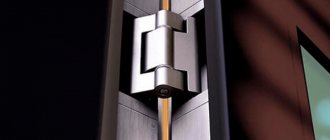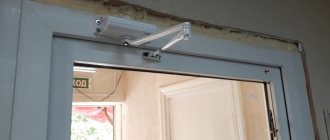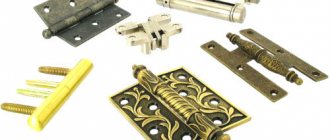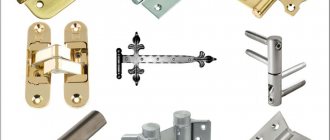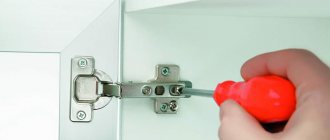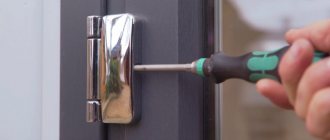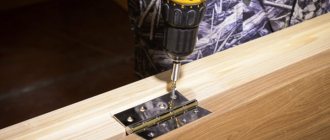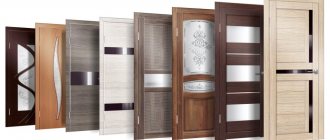Purchasing high-quality interior doors from reliable manufacturers and their correct installation can save the buyer for a long time from product breakdowns and the need for repairs. But despite taking these measures, violation of operating requirements often leads to a number of problems. In this case, it is possible that adjustment of the hinges of interior doors or their complete replacement may be required.
The need to adjust the hinges of interior doors
The service life of interior doors depends 70–75% on their quality.
The remaining share of influence is distributed among the following factors:
- quality of installation work;
- correctness of the adjustment of hidden hinges;
- compliance of operation with established standards (depending on the material from which the doors are made);
- degree of accuracy in using the structure;
- availability of necessary care;
- lifetime.
The hinge adjustment service ordered from a specialist is often expensive. If minor problems arise, for example, with opening and closing the sash, in many cases you can cope with the situation on your own. This does not require special skills.
This also applies to problems such as:
- subsidence of the door leaf;
- spontaneous opening and closing of the structure;
- touching the bottom of the floor covering, etc.
Installation
For installation you may need the following tools and accessories:
- limiter ring;
- racks for fixation;
- template for inserting loops;
- hex bit;
- drill;
- drill;
- knob;
- clamps;
- holder.
Experts recommend adhering to the following technology.
- Fix the door to the floor in order to install the hinges as correctly as possible. Furniture stores have special racks for fixing them, but you can make them yourself.
- Mark the canvas and the block (the places where the hinges will be mounted).
- Using a clamp, secure the template to the canvas (it makes the work easier). A template is often included in the package; if it is not included in the set, you can purchase it separately or draw it yourself.
- Drill holes with a drill of the required diameter and insert the rods. The depth should be equal to the length of the parts, and the number should correspond to the number of rods.
Door preparation:
- fix the parts in the marked places with screws;
- install the sash part of the hinge on the frame;
- secure decorative elements.
When installing two loops, the distance from the top and bottom should be from 15 to 20 cm. If a larger number is required, the distance from the top and bottom can be reduced to 8–12 cm.
Features of hexagon adjustment
For fastening accessories, incl. and door hinges, hex socket screws are often used.
To adjust the equipment using this tool, you need to perform the following steps:
- Select a hexagon that fits the size of the fastener.
- Insert the tool into the recess of the corresponding fitting element until it stops.
- Apply force and rotate the hexagon. Increase the load until torsion is achieved.
Using a hexagon is more convenient than using a regular screwdriver. In terms of technical characteristics, it is 10 times superior to other similar tools. The main feature of the hexagon is its high torsion rate.
Types of canopies
A variety of door hinges allows you to choose which way the door will open
Therefore, in order not to regret the decision after its installation, it is important to decide in advance on the type and principle of operation of the hinges
Butterfly loops
They are the most practical for interior doors. Butterfly loops got their name because of their characteristic shape - when open, they resemble the wings of a butterfly. When folded, the canopy is one card thick. This is achieved thanks to a special shape ─ when closing, one “wing” of the butterfly is precisely marked into the cutout of the second.
When installing such hinges, it is very important to select suitable screws. Since the two parts of the butterfly’s “wings” will be in direct contact with the wood, you should use screws whose caps will be ideally hidden in a special groove in the hinge
With the right choice, the sash will close well and no additional difficulties will arise during its use.
Experts do not recommend installing butterfly canopies on large and medium-heavy doors, since the thin metal and the very openwork of the structure are more suitable for using them as a decorative element.
Simple mortise
This is the most widely known type of awning. It is used in almost every home. It consists of two parts and is secured with ordinary wood screws.
Invoices
Structurally, they are not much different from the previous ones, but there are still some differences. The main nuance that should be taken into account when installing these canopies is the installation method. If the previous option is simply attached to the end of the door, then for this type of hinges it is necessary to make special recesses (embed in). This is necessary in order to hide the fastening plates and create a smaller gap between the door frame and the jamb.
How to adjust loops - instructions
Before you begin adjusting the hinges yourself, you must:
- Find out the cause of the problem. In case of incorrect opening/closing of the door leaf, you should check the vertical position of the elements using a plumb line. To determine the tightness of the fit, it is recommended to place a sheet of paper between the door leaf and the frame.
- Prepare problematic structural elements for upcoming work. It may be necessary to remove the door leaf to gain access to the hinges.
After completing the preparatory work, you can begin the repair. The algorithm of actions depends on the cause of the problems.
Required Tools
Before adjusting the interior door, you need to prepare everything you need. This is necessary for simple and convenient work. You will need the following:
- chisel;
- oily liquid for lubrication of canopies;
- screwdriver;
- plane;
- building level;
- hammer;
- plumb line;
- simple pencil.
If there is a loose fit
One of the most common breakdowns that occur during the operation of interior doors is sagging of the leaf and its loose fit.
This problem is most relevant for heavy and massive structures. Common causes of a door not fitting tightly:
- distortion that occurs at the joints of the loops;
- insufficient depth of hinges into the door frame.
To eliminate the skew, you must perform the following steps:
- Remove the door leaf from the hinges.
- Remove any remaining foam and decorative elements.
- Identify places of distortion using measuring instruments.
- Secure the embedded beams that serve as supports for the door frame. If they are connected at a 45 degree angle, a horizontal screw should be used to hold them together.
- Strengthen the box by screwing in additional screws.
- Fill the resulting voids with polyurethane foam. It is important to take into account that when dried, its volume increases by 2 times. To avoid deformation of the beams, before using foam, it is recommended to carefully read the instructions for its consumption.
- Install doors and decorative trims.
In order not to damage the door leaf and frame, it is recommended to carry out work with great care.
If the problem arose due to insufficient depth of the hinges into the door frame, you will need to tighten the fixing screws as much as possible.
If this measure turns out to be ineffective, you will need to remove the hinges and deepen the niche.
Attention! If the hinges are unsuitable for further use, they must be replaced. In this case, it is recommended to choose fittings of a larger size than the previous one. If the door leaf has a large mass, it is advisable to install a third (additional) hinge. This will help take the load off the two main ones.
Working with steel and wooden doors
Steel and wooden doors have more weight than, for example, plastic ones. And therefore, the hinges on them break much more often.
To adjust hinges on steel and wooden doors you need to:
- Carefully inspect the door and listen to the sounds that are made when it moves.
- Select the screw closest to the friction point and loosen it slightly.
- Shake the door with gentle movements.
- If there is still a squeak, continue to loosen the screw a little at a time.
- When there is no creaking left, use a building level to ensure that the door leaf is parallel to the door frame and perpendicular to the ground.
- Fasten all the loops.
When opening tightly
The reasons for a tight opening of an interior door may be:
- excessive deepening of loops
- swelling of the door leaf or frame.
In the first case, you will need to adjust the hinges, according to the algorithm of actions described in the previous paragraph, or reinstall the fastening elements.
Swelling of the canvas is a problem typical for wooden structures. To eliminate it, it is necessary to give the door its original geometric shape. The procedure consists of carefully removing part of the solid wood in problem areas using a plane. Then a layer of paint should be applied to the damaged surface.
Possible causes of malfunctions
There are several main factors that cause problems or the need for adjustment of walk-through structures:
- installation of new sashes;
- violation of the geometry of individual elements;
- box deformation;
- poor fit of loops.
When a problem occurs, a characteristic symptom appears.
Which interior doors to choose for an apartment: types, description of advantages and reviews
When opening spontaneously
The reason for spontaneous opening/closing of the door may be improper installation of the frame, namely, tilted forward or backward.
To solve the problem, you will need to adjust its position. When opening or closing the door yourself, you should align the frame vertically. In this case, the beam on which the fittings are installed is subject to adjustment. You should also check the hinges for their alignment.
If the box is installed correctly and the fittings are located on the same axis, it is recommended to replace the hinges with new ones. The reason may lie in their wear and tear.
Where is it used?
Screw-in hinges are also called pin hinges; they are installed on doors with a hinged part (with a quarter). Instead of regular slats, they have small rods that are screwed into the block and the canvas.
The dimensions and weight of the door determine the choice of screw-in hinge model. For lightweight folding sashes and swing doors, you need to choose awnings with 2-3 rods. For large and heavy doors, hinges with four rods are used - such models are made of special steel and can withstand heavy loads.
The advantage of such fittings is easy adjustment using a hexagon. It can be adjusted in height or horizontally, as well as in the clamping area.
Butterflies
“Butterfly” is one of the varieties of overhead one-piece loops.
It is suitable for doors with low weight. This model got its name due to the similarity of its shape to the wings of a butterfly. Professionals call such a loop a card loop. The butterfly can be adjusted in different planes:
- Horizontally. The work is done using the adjusting screw. You should loosen it a little and level the door. It is recommended to alternately loosen and tighten the screw, checking the result each time.
- Back and forth. You need to slightly loosen the fixing screw on the overhead hinge. Then, by tightening and loosening it, you should align the door.
- Vertically. Adjustment is made using the upper and lower screws on the installation pad.
To perform the work efficiently and achieve the desired result, actions must be precise and accurate.
Where is it used?
Screw-in hinges are also called pin hinges; they are installed on doors with a hinged part (with a quarter). Instead of regular slats, they have small rods that are screwed into the block and the canvas.
The dimensions and weight of the door determine the choice of screw-in hinge model. For lightweight folding sashes and swing doors, you need to choose awnings with 2-3 rods. For large and heavy doors, hinges with four rods are used - such models are made of special steel and can withstand heavy loads.
The advantage of such fittings is easy adjustment using a hexagon. It can be adjusted in height or horizontally, as well as in the clamping area.
Positive traits:
- different colors;
- complete with decorative caps;
- made of non-ferrous metal, mainly aluminum (plastic pin hinges are used for lightweight doors or windows);
- high wear resistance;
- beautiful appearance and compactness.
Among the disadvantages is the appearance of noise during operation, but models with a special plastic insert can solve this problem.
Screw-in mechanisms are universal - there is no need to choose for the left or right side. The canvas on such hinges cannot be removed, which can be attributed to both disadvantages and advantages.
The caps cover the rods and act as a decorative element. They are available in a variety of colors and can be chosen to suit any interior.
Hidden
Adjusting the hidden hinges of interior doors does not require dismantling the door leaf.
If you start working immediately after detecting a problem, the adjustable gap can be quickly restored to the required level. If you postpone repairs until a later time, the canvas may shift or begin to sag. In this case, it will be much more difficult to fix the problem.
Work is carried out simultaneously in several planes.
To troubleshoot, follow these steps:
- Adjust the canvas in height, setting a certain gap at the bottom and at the same time maintaining it at the top.
- Adjust the door leaf horizontally, aligning the door with the frame.
- Adjust the pressure by turning the adjusting eccentric. As a result of this action, the door leaf should be pressed against the frame along the entire perimeter.
The adjustment size ranges from 1 to 5 millimeters depending on the manufacturer.
Rubbing the canvas
If during operation the sash rubs against the frame, metal is visible from under the decorative coating, it needs to be adjusted.
In this case, the input adjustment is carried out as follows:
- Use a socket wrench to loosen the fastening of the middle canopies. You should also loosen the loop at which friction is observed.
- The canvas is moved to the side towards or away from the box. This depends on the direction in which the misalignment is detected. The end nut is then tightened.
- The sash is “rocked” a little until the hinges return to their original place.
- After this, tighten the fastening.
- Then you need to open and close the sash several times to check the effectiveness of the work done.
If the friction has decreased but remains, the procedure must be repeated. If the hinges are worn out significantly, adjustment will not help them. You need to buy new fittings.
Hinges with closer
Adjustment of hinges with a closer is carried out in three directions:
- Vertically - by loosening the fastening elements located in the side parts of the hinge body and aligning them with subsequent fixation.
- Horizontally - using an eccentric located in the central part of the body.
- In depth - by rotating a special screw located in a groove on the body.
The serviceability of interior doors is influenced by multiple factors. They can lead to problems in the operation of the structure. If you start repairs in a timely manner, in most cases the breakdown can be fixed on your own without additional financial costs. This will require a minimum set of tools. But sometimes repairs may not lead to the desired result. In such cases, a complete replacement of the entire door unit is required. To prevent things from going to extreme measures, it is recommended to regularly carry out preventive maintenance of its operation.
Proper maintenance of fittings
The most important condition for the long service life of hinges is their regular lubrication. In this case, the hinges will not only serve for a long time, but will also stop making squeaks and various extraneous sounds.
Hinges can be lubricated with many types of oil and special lubricants:
- Machine oil is good for lubrication. The effect lasts quite a long time.
- Graphite - you can purchase it at a specialty store, or you can use the lead of a regular pencil. It must first be crushed. The effect is very long-term and reliable.
- Special lubricant WD-40 . Known to everyone for its universal properties for lubrication of both spare parts of equipment and doors. Ideally eliminates squeaks.
- Solid oil - a creamy structure will allow you to lubricate the hinges for a very long time. The disadvantage is that it sticks to your hands and some types have an unpleasant odor.
- Wax - does a good job of lubricating the door. You can also use paraffin from candles.
You cannot lubricate door hinges with vegetable oil - this will have the opposite effect. Dust and debris will adhere to the oil, causing further damage to the hinges.
Doors, like any piece of furniture, tend to lose their original properties over time. They can sag, creak, open on their own and in every possible way disturb the comfort of the home. To avoid this, it is necessary not only to choose hinges for doors wisely, but also to be able to regulate them and carry out preventive measures.
Adjusting the locking mechanisms
The initial stage is disassembling the device. It will depend on the design features whether it will be necessary to dismantle the linings, locking mechanisms and remove the handles. The main method of adjustment and correction will be determined by the symptoms of malfunctions.
If the door lock is jammed, lubricate the latches with machine oil or grease. When lubricating, rotate them so that the liquid spreads throughout all the insides of the mechanism.
If the lock has a short hidden tongue, then there are adjustments for the extension of the tongue, which is built inside the handle. You can adjust the reach by rotating a screwdriver in a special groove. This applies to both the locking mechanism tongue and the handle tongue.
Door structure
Many homeowners, when purchasing new doors, intend to install them themselves. This is motivated by the widespread belief that installing an interior door differs from an entrance door and is much easier to carry out. This is true. But for the installation to be as successful as possible, you need to know the complete structure of the structure, as well as all the possible nuances of its assembly.
The main elements should be listed:
- Canvas;
- Box;
- Platbands.
The latter act more as decoration, but it is rare that a door structure can do without them. Especially the swing one. They are needed to hide all seams and joints, as well as to decorate the overall appearance.
For double-leaf models or coupe doors, additional parts will be needed:
- Threshold;
- Connecting key;
- Fake bar.
You may also need extensions, a door closer, a transom and a transom. And handles, latches and locks, in addition to their main function, serve as additional decor.
